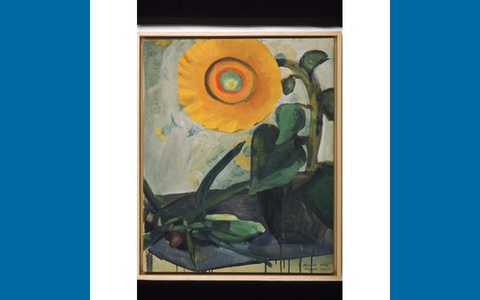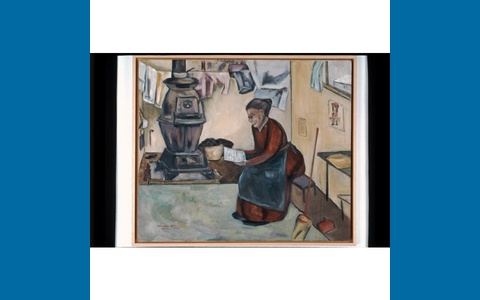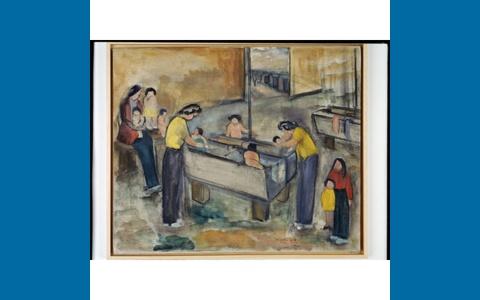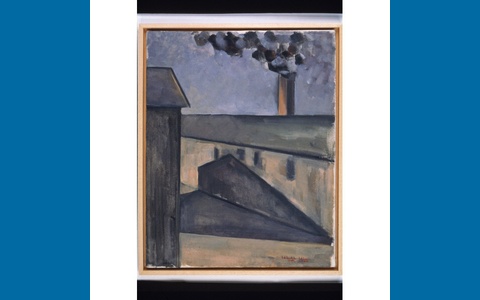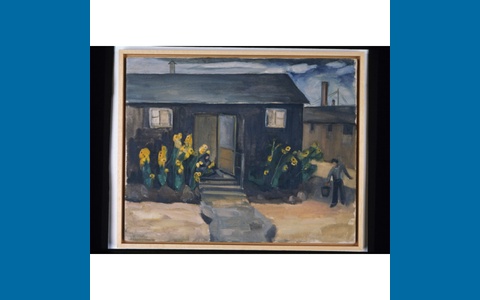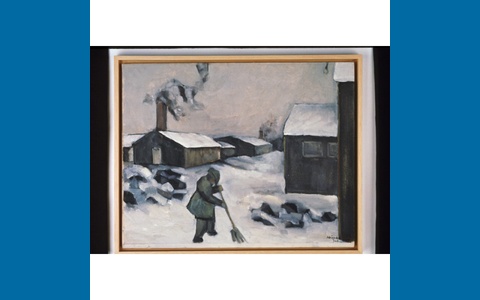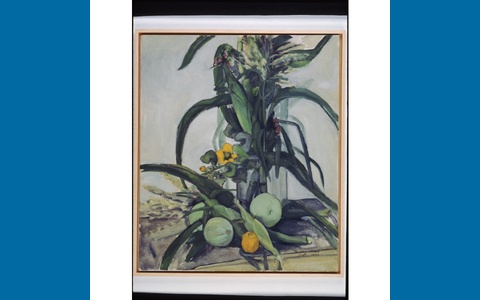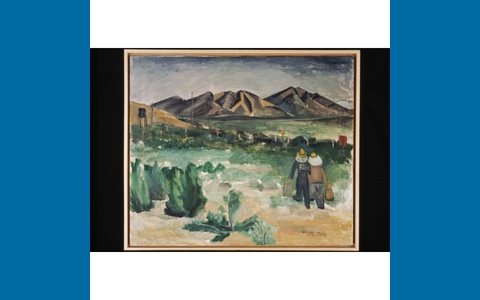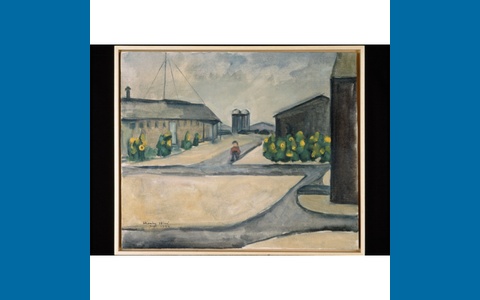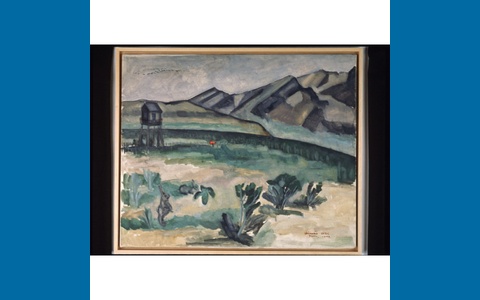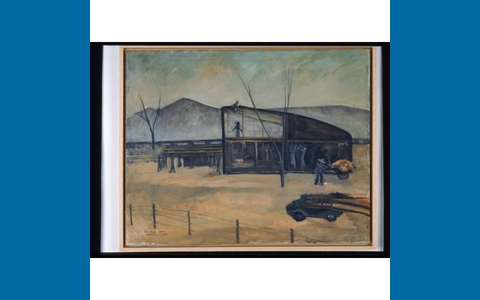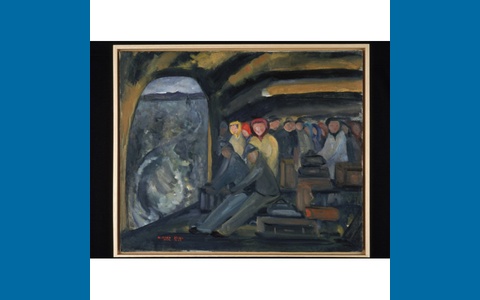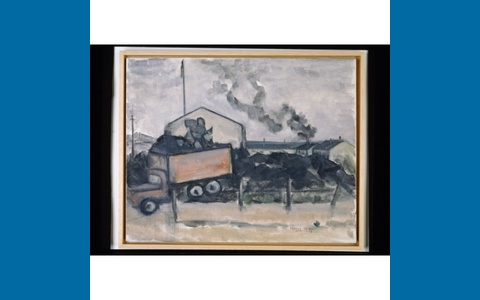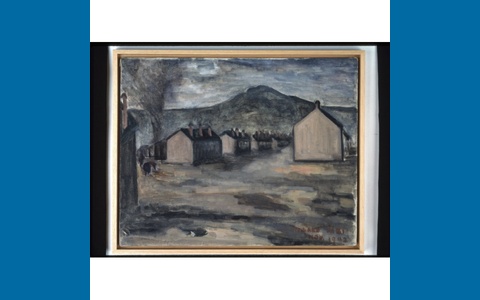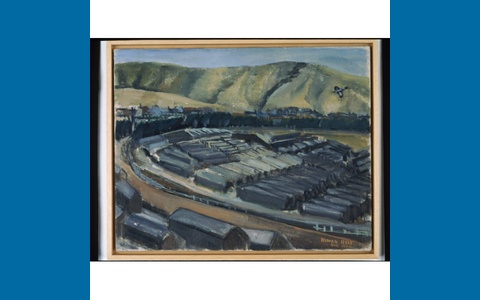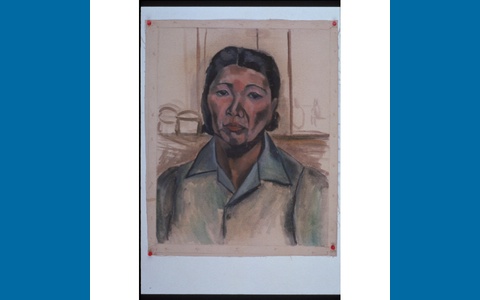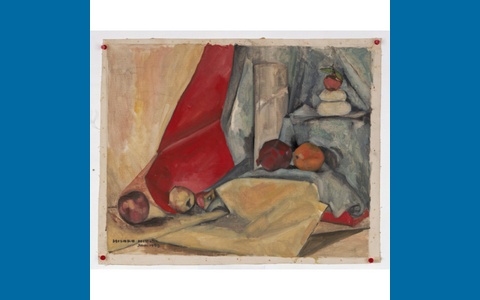Hisako Hibi
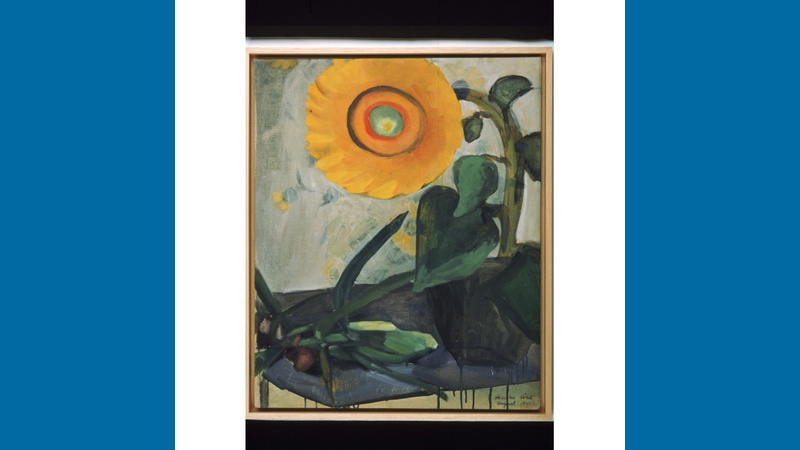
Hisako Hibi
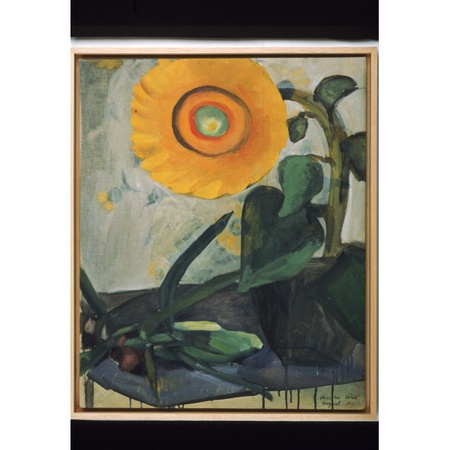
Hisako Hibi - "Topaz flower-sunflower and corn"
I feel this picture is rightfully placed at the end of this collection, for multiple reasons. First, Hisako was very fond of this flower, the sunflower, because regardless of the harsh weather conditions at Topaz, it grew and it flourished. Perhaps she was so fond of these characteristics because she and the rest of the prisoners shared these traits with the sunflower. No matter what they went through, these people that were unjustly forced into this desolate environment were able to still survive and thrive.
--
Description
Unframed stretched canvas. Image of sunflower in pot on table, ears of corn laying to the left.
Inscription
Signed LR: Hisako Hibi / August 1945 ; BACK: Topaz Flower only the sunflower grew well in Topaz. They grow so high. The flowers so large, in the hot sun, and desert land, in the severe weather the very strong flower
History
This painting appears to be an unfinished work done in the last few months that Hisako Hibi and her family were at Topaz concentration camp. The colors are rather muddied and it seems as though Hibi painted this image over another one. The image of another painted sunflower is visible beneath the top layer of paint. Rings of color are used to depict the sunflower that dominates the canvas. There is little modeling or detail in this work. Drips of paint are also evident in this work, suggesting the unfinished nature of the painting. In the inscription on the back Hibi notes her admiration for the sunflower that thrived in the desert climate.
painting
H: 22 in, W: 18 in
canvas
oil
Topaz, Utah, August 1945
(96.601.55)
Gift of Ibuki Hibi Lee
Hisako Hibi Collection
To see other collections:
Japanese American National Museum Collections Online
Copyright is held by the Japanese American National Museum. Short-term educational use with limited circulation is permitted. For all other uses, please contact the Hirasaki National Resource Center at the Japanese American National Museum (hnrc@janm.org)
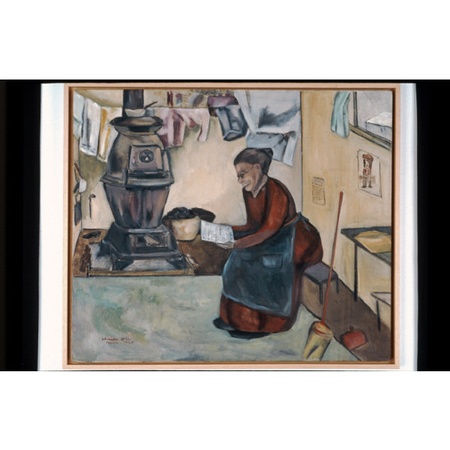
Hisako Hibi - "A letter" (Hisako Hibi "A letter" (Hisako Hibi - "A letter"))
This painting is rare, for Hisako did not often create art of images and things inside the barracks. This painting includes all that would have been inside of a typical room. It includes the pot belly stove, which was powered by coal, laundry hanging from the wall, a broom, etc.
--
Hisako Hibi "A letter" (Hisako Hibi - "A letter")
Artist Hisako Hibi was born in Japan in 1907 and immigrated to the United States in 1920, at the age of fourteen. In 1926, she entered the California School of Fine Arts, where she studied painting and met her future husband, Matsusaburo Hibi. Their happy life with their two young children in Hayward, California, was disrupted in 1941 with the bombing of Pearl Harbor. On May 8, 1942, the Hibi family left their home for Tanforan Racetrack, ultimately spending the rest of the wartime years at Topaz in Utah. These years, and those that followed, were “depressing times for [Hisako], filled with uncertainty and fear,” relates her daughter, Ibuki. Her paintings of camp life were often grim. This painting, in which an elderly woman sits reading a letter, captures some of the painful dislocation caused by the internment experience. The letter, which begins “Dear Mother,” is presumably written to the woman from one of her children who has left the camp, perhaps to work in an Eastern or Midwestern city or to serve with the armed forces. Although Hibi’s children were not of the age that they would leave her to search for employment outside the camp, the painting captures her empathy for the subject matter. Painted in March of 1945, when more and more Nisei were being allowed out to look for work and the government was already beginning the process of resettlement, this sort of familial separation would have been becoming a more frequent occurrence.
--
Description
Unframed stretched canvas. Image of elderly woman in red dress and dark apron seated reading letter. Pot belly stove to the left, laundry hanging in background, broom and dustpan to her right.
Inscription
Signed LL: Hisako Hibi / March 1945
History
This painting is the only example from this collection of an interior scene of one of the barracks. In this work Hisako Hibi provides a detailed and close view of one of the barrack "apartments" that families were housed in. A woman is seated slightly hunched over as she reads a letter. Her oval shape is echoed by the pot-bellied stove which stands sightly behind her and to the left. Although we do not know much about the woman, it is important to note that Hibi does identify her as a mother. The occasion of the letter is clearly significant and Hibi allows the viewer to see the opening of the letter which reads, "Dear Mother." This letter could have been from a son or daughter who had relocated outside of camp for a number of different reasons. Many young Japanese American men volunteered or were drafted into the US army, so it is possible that this letter is from the woman's son who became a soldier. Other young people were allowed to begin or resume their college educations in schools outside of the West coast. Many went to places in the Midwest and some went to the East coast. Still other individuals found work in other parts of Utah and places where there was a shortage of agricultural labor because of the war. The resettlement project conducted by the WRA was a complicated one. Its main purpose was to prevent Japanese Americans from repopulating the West coast which was considered vulnerable to attack by the Japanese. Thus, the letter referred to in this painting could have referenced a number of different situations. Hibi provides other details of the living quarters, including the hanging laundry and the drawing pinned to the wall behind the woman. (This drawing apparently refers to a picture made by Ibuki Lee, the artist's daughter, when she was a child.) The presence of the hanging laundry and the broom and dustpan at her side suggest that the woman may have interrupted her chores to read this letter.
painting
H: 22 in, W: 26 in
canvas
oil
Topaz, Utah, March 1945
(96.601.51)
Gift of Ibuki Hibi Lee
Hisako Hibi Collection
To see other collections:
Japanese American National Museum Collections Online
Copyright is held by the Japanese American National Museum. Short-term educational use with limited circulation is permitted. For all other uses, please contact the Hirasaki National Resource Center at the Japanese American National Museum (hnrc@janm.org)
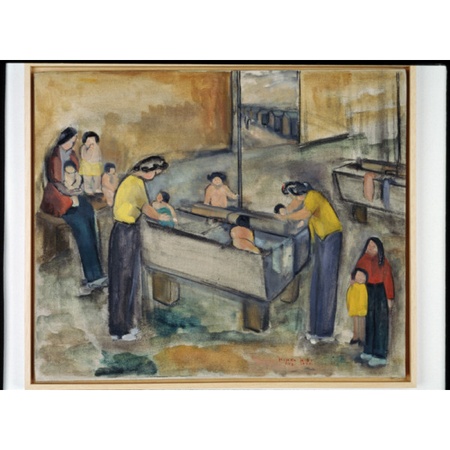
Hisako Hibi - "Laundry Room"
Laundry rooms and latrines were all communal. In addition, they were poorly equipped and maintained. The bathroom only had four bathtubs, so women would wash their young children in a laundry room sink, as is depicted here.
--
Description
Framed, stretched canvas. | Image of women in slacks bathing children in laundry sinks at laundry room of Topaz concentration camp, Topaz, Utah. Two women in yellow shirts stand at either end of industrial sinks washing children; two children stand in sinks waiting. Girl in red top stands with her arm around a smaller child in yellow at BR. A woman in red jacket sits on a bench holding a child in her lap leaning against back wall, left; two children wait beside her. Another sink is visible at midground right. Open doorway in background reveals row of barracks.
Inscription
We only had four bath tubs. Mothers bathed children in the laundry room.
History
Daily life in Topaz concentration camp included having to cope with the inadequate laundry and latrine facilities. These spaces were designed to be completely communal, for example, individual stalls were not even equipped with doors. This resulted in a lack of privacy and embarassing situations for internees. In addition, there were often long lines to use these facilities. Hibi herself noted in her writing that the bath tubs seemed to be almost always occupied. As a result, many mothers remedied the situation by bathing their children in the sinks built for washing laundry. On the back of this painting Hibi wrote, "We only had four bath tubs. Mothers bathed children in the laundry room." Three women and nine children are depicted in this painting. As was typical for Hibi, her figures lack specificity and detail. In the background an open doorway reveals a row of barracks so that the setting is unmistakably that of the concentration camp.
painting
Canvas
oil
Topaz, Utah, April 26, 1945
(96.601.15)
Gift of Ibuki Hibi Lee
Hisako Hibi Collection
To see other collections:
Japanese American National Museum Collections Online
Copyright is held by the Japanese American National Museum. Short-term educational use with limited circulation is permitted. For all other uses, please contact the Hirasaki National Resource Center at the Japanese American National Museum (hnrc@janm.org)
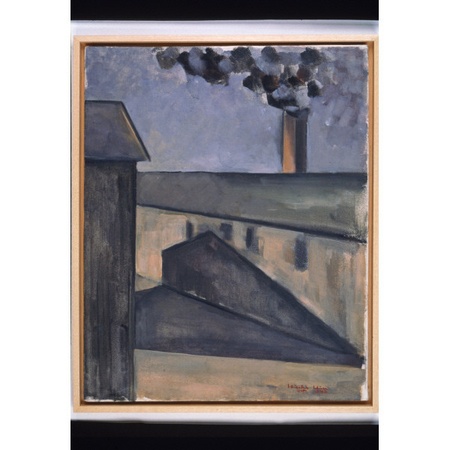
Hisako Hibi - "Shower, latrine and laundry building"
The showers, latrines and laundry facilities were often in the same building, as is suggested here. Often times, people would stay up until very late to take a shower in order to avoid any embarrassement or shame.
--
Description
Unframed, stretched canvas. Image of barrack with chimney and smoke, portion of another barrack at left, casting shadow on right barrack.
Inscription
Signed LR: Hisako Hibi / Oct. 1944
History
This painting demonstrates Hisako Hibi's concern with composition. The focus appears to be less on landscape, and more on shapes creating a sense of pattern. The corner of one bulding is depicted in the foreground and frames the painting at the left. Its shadow falls dramatically across the side of the building at the right. This creates sharp geometric patterns in this work. The viewer is positioned slightly outside of this space, but at ground level. There is no escape out of the closed quarters of this alleyway. Hibi utilizes broader brushstrokes so that there is less modulation of the surface of the canvas.
painting
H: 20 in, W: 16 in
canvas
oil
Topaz, Utah, October 1944
(96.601.49)
Gift of Ibuki Hibi Lee
Hisako Hibi Collection
To see other collections:
Japanese American National Museum Collections Online
Copyright is held by the Japanese American National Museum. Short-term educational use with limited circulation is permitted. For all other uses, please contact the Hirasaki National Resource Center at the Japanese American National Museum (hnrc@janm.org)
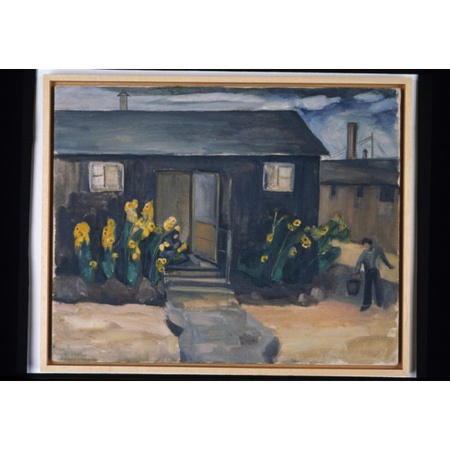
Hisako Hibi - "In front of my apt."
Again, Hisako included sunflowers in her painting to show how possible it was grow something so beautiful in such a desolate environment. This "home" looks pleasing to the eye. However, we must not forget that these rooms were very small, and did not offer much protection from outside elements such as wind, cold and dust.
--
Description
Unframed stretched canvas. Image of a young man by a barrack with a pail in his hand. There are sunflowers that are planted in front of the barracks. The door to the barrack is open.
Inscription
BACK: Front of my APT 16-8 A+B Last day of August 1944 Ibuki Hibi
History
This is the only known painting to portray the specific barrack apartment occupied by the Hibis at Topaz concentration camp. Most of Hisako Hibi's works do not provide details of individuals or buildings. In this work Hibi focuses on the exterior of her particular living quarters. The small garden of flowers is in full bloom adding a spark of color to the drab barrack walls. A young boy, possibly meant to be Hibi's son, appears at the far right carrying a bucket. The viewer imagines that he is probably going to water the plants. In the doorway is a seated figure who is slightly obscured by the tall plants. The little gravel pathway further adds to the appearance of a tidy, cheerful home. In fact, the individual spaces allotted to families was a room only about 16 feet by 20 feet. The high winds constantly blew dust and dirt into the barracks through the cracks in the floor and the shoddy tar-papered walls. However, the portrait of the Hibi home is a relatively sweet one, without overt indications of the difficulties of camp life.
painting
H: 16 in, W: 20 in
canvas
oil
Topaz, Utah, August 1944
(96.601.41)
Gift of Ibuki Hibi Lee
Hisako Hibi Collection
To see other collections:
Japanese American National Museum Collections Online
Copyright is held by the Japanese American National Museum. Short-term educational use with limited circulation is permitted. For all other uses, please contact the Hirasaki National Resource Center at the Japanese American National Museum (hnrc@janm.org)
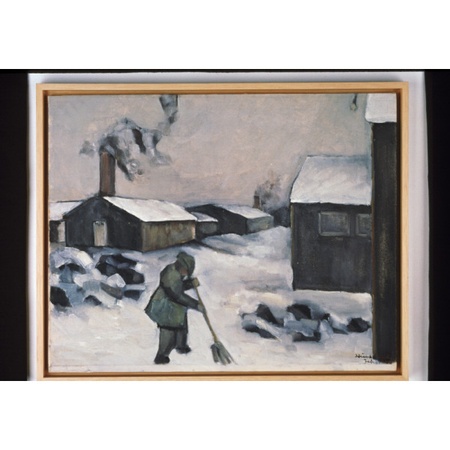
Hisako Hibi - "A cold day"
The Topaz concentration camp could get very cold in the winter time. This picure highlights the black smoke exiting the chimneys of the barracks. This smoke is from the burning coal, the one source of fuel for warmth in the concentration camps.
--
Description
Unframed, stretched canvas. | Image of a person shoveling snow or coal in foreground next to piles of black rocks, probably coal, in front of barracks at Topaz concentration camp, Utah. Smoke rises from chimneys of snow covered barracks in background.
Inscription
Signed, LR: Hisako Hibi / April 1944
History
Central to this painting is the figure in the foreground who seems to be shoveling snow or coal. Like most of the people in Hibi's camp paintings, the figure is anonymous and generally unidentifiable. The piles at the right and left are probably coal which was needed for the pot-bellied stoves. Every "apartment" had such a stove that served as the only source of heat during the severely cold winters at Topaz. Coal supplies were unpredictable and internees were responsible for gathering what coal they could from a central location to their living quarters. This figure is probably in the midst of collecting more coal for the barracks. Thick black smoke rises from the chimney in the background, referencing the burning coal in one of the pot-bellied stoves. Absent from this painting are many of the usual signifiers that this is a camp setting. The typical rows of barracks has been replaced by a small cluster of buildings. The barbed-wire fence and guard towers are also missing. It is a serene scene of a cold and snowy landscape.
painting
H: 16 in, W: 20 in
canvas
oil
Topaz, Utah, February 1944
(96.601.38)
Gift of Ibuki Hibi Lee
Hisako Hibi Collection
To see other collections:
Japanese American National Museum Collections Online
Copyright is held by the Japanese American National Museum. Short-term educational use with limited circulation is permitted. For all other uses, please contact the Hirasaki National Resource Center at the Japanese American National Museum (hnrc@janm.org)
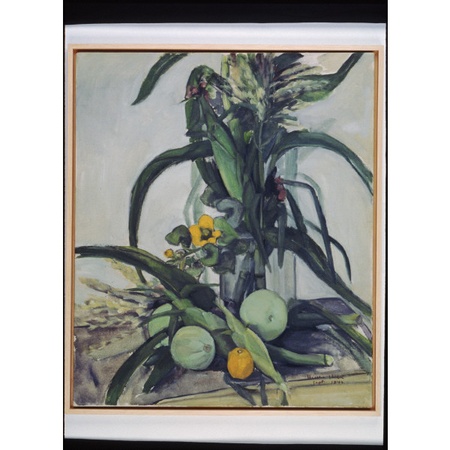
Hisako Hibi - "Topaz Farm Products"
As mentioned previously, the people at Topaz concentration camp did what they could to beautify their environments. These farm products are a result of the Topaz agricultural department, which was created as a way to pass the time at camp. The produce from these gardens helped supplement the much less nutritious food that was served at the mess halls.
--
Description
Framed, stretched canvas. Lush, green still life with orange colored fruit at BC. Framed for exhibition.
Inscription
Signed LR: Hisako Hibi / Sept. 1944 ; Verso: written on canvas "Tribute to Topaz Agricultural Dept. They provided us the fresh vegetables. They feed us with finest, freshest vegetables. The Topaz Products of the Agricultural Dept."
History
The Topaz agricultural department was created for a few different reasons. It was one way to pass the time during the otherwise boring days. There were also quite a few professional gardeners in the Japanese American community who put their expertise to work for the betterment of their fellow internees. The products of the agricultural department provided vegetables and flowers to the internees. The vegetables were important in supplementing the often mediocre army ration meals served in the mess halls. The fresh vegetables were thus highly prized by the internees. The plants and flowers also helped beautify the camp surroundings which lifted the spirits of at least some of those at Topaz. Hibi repeatedly remarked on her admiration for those who cultivated the alkaline soil of the desert.
painting
W: 22 in, Frame: 27 x 23 in, H: 26 in
canvas
oil
Topaz, Utah, 1944
(96.601.32)
Gift of Ibuki Hibi Lee
Hisako Hibi Collection
To see other collections:
Japanese American National Museum Collections Online
Copyright is held by the Japanese American National Museum. Short-term educational use with limited circulation is permitted. For all other uses, please contact the Hirasaki National Resource Center at the Japanese American National Museum (hnrc@janm.org)
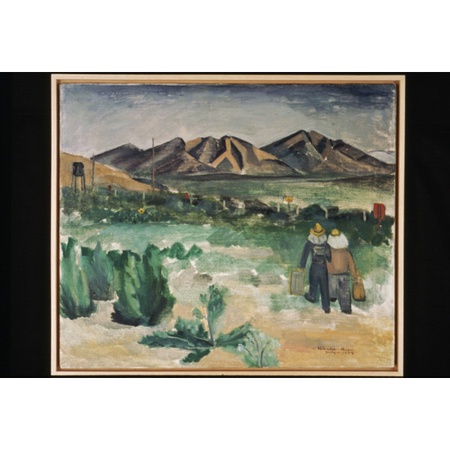
Hisako Hibi - "Treasure hunting"
After some time, the prisoners were allowed to go out on small, monitered excursions outside of the barbed wire boundaries. On these trips, some people found arrowheads belonging to native american tribes that had once inhabited the area, topaz, and other "treasures." We must remember that although they were allowed outside of the gates, they were still being watched, as is apparent from the presence of the guard tower here.
--
Description
Unframed stretched canvas. Image of two men walking in a field with a guard tower in the background. Thee are signs on a fence and mountains beyond the field.
Inscription
Signed, LR: Hisako Hibi / July 1944 ; BACK: When WRA regulations were eased a little, we were allowed to go out some part of the restricted area a bit of freedom we enjoyed going out we had to cover up our faces, hands and legs because there were many mosquitos + insects + so on 'Hisako Hibi Going to pick some shells'
History
After some time camp administrators decided to allow internees outside the barbed wire fence into restricted areas. Many internees took advantage of these opportunities to take little excursions. Parents and children often went in search of arrowheads, evidence of the former Native American civilization that occupied the area. The area where Topaz was located was also rich with fossil remains and actual semi-precious Topaz stones. Internees often gathered the small bits of Topaz to fashion into jewelry and crafts. Hibi wrote about going on this kind of "treasure hunt" with her family and the need to be covered virtually from head to toe, in order to protect themselves from the mosquitoes. In this painting Hibi depicts two internees going out on their "treasure hunt", appropriately dressed according to Hibi's description. Red and yellow warning signs dot the barbed wire fence that remained around the camp perimeter. Despite the taste of freedom offered by this rare opportunity, the guard tower and fence remain as reminders that the freedom offered was still limited.
painting
H: 22 in, W: 26 in
canvas
oil
Topaz, Utah, July 1944
(96.601.33)
Gift of Ibuki Hibi Lee
Hisako Hibi Collection
To see other collections:
Japanese American National Museum Collections Online
Copyright is held by the Japanese American National Museum. Short-term educational use with limited circulation is permitted. For all other uses, please contact the Hirasaki National Resource Center at the Japanese American National Museum (hnrc@janm.org)
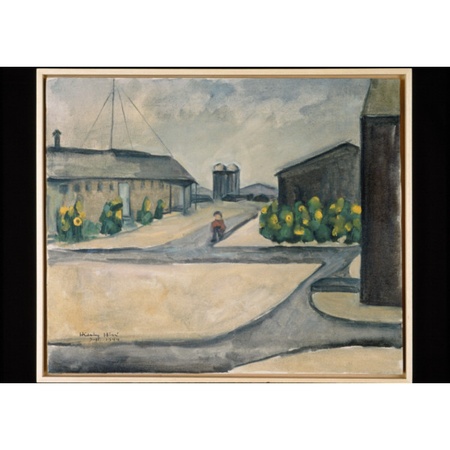
Hisako Hibi - "Water tank"
Sunflowers were one of the only types of flowers that could be grown in the desert climate of Utah. This painting is evidence of the effort made by the prisoners to beautify their otherwise desolate and bleak environment. They did so through such things as gardens and gravel paths/roads, as shown here.
--
Description
Unframed stretched canvas. Image of a child walking down a sidewalk with barracks and sunflowers. There is a water tank in the background.
Inscription
Signed, LL: Hisako Hibi / Sept 1944
History
Topaz concentration camp received its water through a hastily constructed plumbing system. The water tanks located just beyond the confines of the camp were the major supply source. Despite the centrality of the water tank in this painting and the reference to it in the title, the tank itself does not catch the viewer's eye. Instead, the brightly colored sunflowers which line the outside of the two barracks portrayed here draw the viewer's attention. Hibi often remarked on the fact that sunflowers were among the few plants that could be grown in the desert climate. As a way to try and beautify the otherwise drab landscape of Topaz, internees began to plant vegetables, trees and flowers around their barracks. A child appears to walk alone along the gravel paths also created by the internees.
painting
H: 20 in, W: 24 in
canvas
oil
Topaz, Utah, September 1944
(96.601.29)
Gift of Ibuki Hibi Lee
Hisako Hibi Collection
To see other collections:
Japanese American National Museum Collections Online
Copyright is held by the Japanese American National Museum. Short-term educational use with limited circulation is permitted. For all other uses, please contact the Hirasaki National Resource Center at the Japanese American National Museum (hnrc@janm.org)
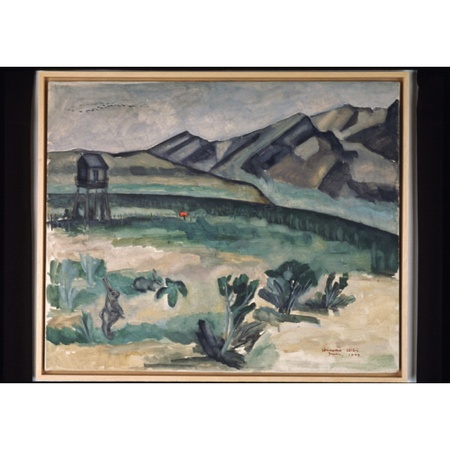
Hisako Hibi - "Limitation"
This painting represents how limited the people in the concentration camps were. They were not allowed beyond or too close to the barbed wire fences shown here. The picture is a reminder of what the Japanese Americans during World War II had to endure in the concentration camps.
--
Description
Unframed, stretched canvas. | Image in hues of gray, brown and green of two rabbits in an open field with a guard tower separated by fence from mountain in background at Topaz concentration camp, Utah. Rabbit stands on its hind legs, BL, while another feeds in field in foreground. Tower located at midground left next to red rectangular sign on low fence. Image is bisected by dark curved line before the mountains. Flock of birds fly above mountains, left.
Inscription
Signed, LR: Hisako Hibi / June 1944 ; BACK: Topaz Utah War Relocation Camp By Hisako Hibi
History
Entitled "Limitation" this painting seems to refer directly to the fact that the camp perimeters were delineated by a barbed-wire fence. Internees were forbidden to go beyond the fence and were monitored by armed guards who surveyed the area from guard towers. There were times when internees were allowed beyond the fence, but this was only under special circumstances. The fences were superfluous because the camp itself was located a far distance from any town so that there was no real chance of escape. In fact, there are no cases of attempted escape at any of the concentration camps. In this work, Hisako Hibi paints a corner of one end of the camp grounds. In the distance, the low barbed-wire fence is visible with a guard tower at the left. One of the red signs which were placed along the wire fence is present in this painting as well. The signs were warnings, not to people who might approach the camp from the outside, but to the internees themselves. They warned against straying too close to the fence and arousing the suspicion of the guards. One of the most tragic events at Topaz was the killing of an internee for walking too close to the fence. A guard supposedly warned the man, who did not follow his order probably because he was hard of hearing. The guard shot the elderly man who later died. This painting does not directly reference this event, but it is concerned with the confinement of camp and the role of the fence and guard towers. A flight of birds in the left corner is perhaps also a symbol for the desire to be free, to go beyond the camp grounds.
painting
H: 20 in, W: 24 in
canvas
oil
Topaz, Utah, June 1944
(96.601.27)
Gift of Ibuki Hibi Lee
Hisako Hibi Collection
To see other collections:
Japanese American National Museum Collections Online
Copyright is held by the Japanese American National Museum. Short-term educational use with limited circulation is permitted. For all other uses, please contact the Hirasaki National Resource Center at the Japanese American National Museum (hnrc@janm.org)

Hisako HIbi - "Topaz High Under Construction"
When the prisoners first arrived at Topaz concentration camp, many facilities were not yet complete, including Topaz High School.
--
Description
Unframed stretched canvas. Image of a truck with wood in the lower right corner and a man with a wheelbarrow full of wood. They are building a building and there is a mountain and bare trees in the background.
Inscription
Signed, LL: Hisako Hibi / Autumn 1943 ; BACK: High School Auditorium Under Construction
History
Tanforan Assembly Center closed in September of 1942 as the approximately 8,000 internees were moved to the Topaz Concentration Camp in Utah. When the internees arrived they found the new camp still under construction. Aside from additional housing barracks and other facilities, buildings for the elementary and high schools remained incomplete. The barracks that were alotted for the schools were unbearable. There was a general lack of furnishings and proper equipment, as well as inadequate lighting; moreover, the buildings did not even have stoves for heating as did the barracks which housed the internees. Thus, as winter approached in the first few months at Topaz, it became clear that it was too cold to conduct classes in these buildings. By December the problems were resolved and classes resumed. The education system as a whole, however, was plagued with difficulties. In particular, finding qualified and able teachers both from outside of Topaz and among the internees became a major problem. This painting by Hisako Hibi makes reference to the construction work on the Topaz High School which Hibi and other internees must have witnessed in the initial weeks at Topaz. The dusty, desert landscape is depicted offering a sense of the barren and drab space that the internees were forced to inhabit. The usual visual landmarks, such as rows of barracks or guard towers do not appear in this painting. Instead, Hibi includes only a small section of the barbed wire fence which surrounded the camp.
painting
H: 20 in, W: 25 in
canvas
oil
Topaz, Utah, Autumn 1943
(96.601.18)
Gift of Ibuki Hibi Lee
Hisako Hibi Collection
To see other collections:
Japanese American National Museum Collections Online
Copyright is held by the Japanese American National Museum. Short-term educational use with limited circulation is permitted. For all other uses, please contact the Hirasaki National Resource Center at the Japanese American National Museum (hnrc@janm.org)
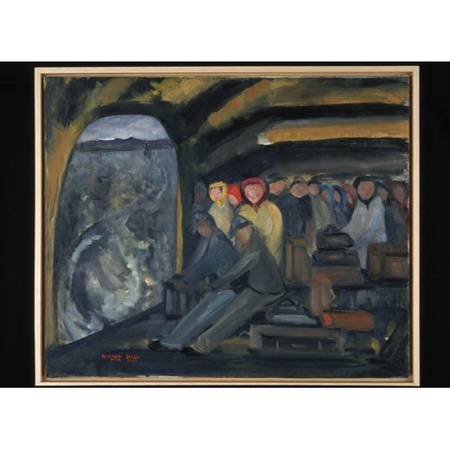
Hisako Hibi - "Shopping to Delta"
The people of Topaz concentration camp were eventually allowed to go to Delta, the nearest town to Topaz, to shop and purchase necessary items. However, only one person per block per week was allowed to go, and the trucks they were transported in were covered entirely, preventing anybody from seeing in or out.
--
Description
Unframed stretched canvas. Image of a compartment full of people with bags. The colors are yellow, black and red.
Inscription
Signed in caps, LL: Hisako Hibi / Sept 1942 ; (Back) A Happy Day to go outside the Camp Delta--a nearest town when the restriction was eased and we were allowed to go out in an army truck but The permission was one person from one block once a week "Shopping to Delta" in an army truck wish to be free to free to liberate body and spirit-- but an army truck No sight seeing because the truck was fully covered. A covered wagon truck!
History
Delta was the nearest town to the Topaz Concentration Camp. Camp administrators eventually allowed internees restricted access to Delta in order to go shopping. A pass was issued to one person from each block per week, thus, internees had to negotiate amongst themselves who would be able to take advantage of this unique privilege. These opportunities were special for a number of reasons. First, the evacuation orders restricted Japanese Americans from taking most of their belongings. All they could take with them into camp was what they could carry, limiting what they could take to the bare essentials. In addition, the majority of the internees at Topaz were from the bay area and were unaware that they would need to be prepared for the harsh weather conditions of the Utah desert. There was a camp store but there was little variety in the items available and its supply was unreliable. The trips also allowed internees some exposure, though limited, to the world outside of camp. Thus, these shopping excursions were valued highly by many internees. The internees were transported in a US army truck on these trips. Hibi offers a depiction of the inside of the truck with several Japanese Americans huddled on one end, while two men appear to be arranging some of the boxes filled with goods. According to Hibi's inscription on the back of the painting the truck itself was covered so that no one could see in and the passengers could not see out. In her painting, however, Hibi ignores proper perspective in her composition in order to show the camp barracks and guard towers in the distance through the back opening of the truck. Therefore, Hibi insists on situating her work within the context of her camp experience.
painting
H: 20 in, W: 24 in
canvas
oil
Topaz, Utah, September 1943
(96.601.19)
Gift of Ibuki Hibi Lee
Hisako Hibi Collection
To see other collections:
Japanese American National Museum Collections Online
Copyright is held by the Japanese American National Museum. Short-term educational use with limited circulation is permitted. For all other uses, please contact the Hirasaki National Resource Center at the Japanese American National Museum (hnrc@janm.org)
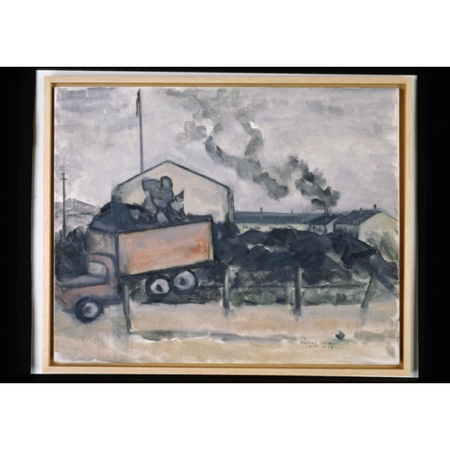
Hisako Hibi - "Coal"
At the concentration camps, families were placed into one bedroom "apartments." These apartments were furnished with a pot belly stove, with which the families were supposed to keep warm during the harsh winters. To get the coal to burn in their stoves, the people had to haul it themselves from the unloading point, wherever that was.
--
Description
Unframed stretched canvas. Image of a red truck in a field with a fence around it. In the background are barracks and smoke.
Inscription
Signed in caps, LR: Hisako Hibi / Sept 1943 ; BACK: Coal Delivery for the Pot Berry (sic) stove
History
At the Topaz concentration camp each barrack was divided into separate spaces, or "apartments" as they were called. In actuality they were small, cramped quarters where families or groups of single men were housed. Each space was approximately sixteen by twenty feet. They were furnished with a pot-bellied stove which the internees used to heat their living quarters. For most internees it was a new experience to use a coal-burning stove. There were sometimes coal shortages which was yet another difficulty of camp life. Internees relied on the coal-burning stoves to provide the necessary warmth in the barracks during the severe winters in Utah. In this painting Hibi depicts a truck making a delivery of this precious commodity. The pile of coal appears as a large mass in front of a building, although it was not always in such great supply. Internees had to gather and haul their own supply of coal from a central place back to their barrack.
painting
H: 16 in, W: 20 in
canvas
oil
Topaz, Utah, September 1943
(96.601.13)
Gift of Ibuki Hibi Lee
Hisako Hibi Collection
To see other collections:
Japanese American National Museum Collections Online
Copyright is held by the Japanese American National Museum. Short-term educational use with limited circulation is permitted. For all other uses, please contact the Hirasaki National Resource Center at the Japanese American National Museum (hnrc@janm.org)
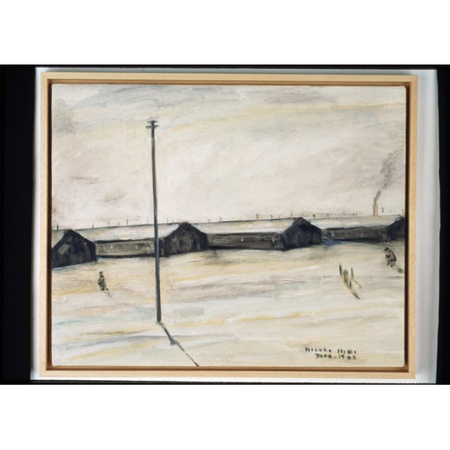
Hisako Hibi - "White Heat"
This is a representation of a harsh Utah winter, which was very different from the San Francisco weather that Hisako and her family were accustomed to.
--
Description
Unframed, stretched canvas. | Image in white, black and grey hues of a utility pole in front of a row of four snow covered barracks at Topaz concentration camp, Topaz, Utah. Lone utility pole stand in foreground left with shadow extending to bottom edge. Two figures at midground, one at far left, the other at far right. Barracks create horizon line. Smoke rises from smokestack of barracks at right.
Inscription
Signed in caps, LR: Hisako Hibi / June 1943. Written on back: White Heat June 1943.
History
Entitled "White Heat" this painting is the first snow-filled landscape painted by Hibi while incarcerated at Topaz concentration camp. The internees were used to the mild weather of the San Francisco Bay Area, thus, the harsh Utah winters were especially difficult. In addition, the facilities of the concentration camps did not provide much comfort from the snow and extreme cold temperatures. In this painting Hibi portrays a row of barracks from a distance with two sketchy figures dotting the landscape. A single electrical pole stands at the left, while some smoke from a chimney rises in the distance. The white expanses of snow and sky border the thin row of barracks. Instead of offering a pristine white land and sky, Hibi utilizes yellow, blue and grey patches of color throughout this landscape scene.
painting
H: 16 in, W: 20 in
canvas
oil
Topaz, Utah, June 1943
(96.601.10)
Gift of Ibuki Hibi Lee
Hisako Hibi Collection
To see other collections:
Japanese American National Museum Collections Online
Copyright is held by the Japanese American National Museum. Short-term educational use with limited circulation is permitted. For all other uses, please contact the Hirasaki National Resource Center at the Japanese American National Museum (hnrc@janm.org)
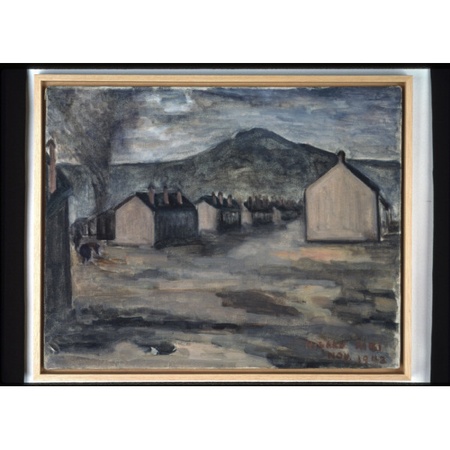
Hisako HIbi - "Topaz, Utah"
This rather desolate and barren looking painting reflects what Topaz concentration camp was like. Families were housed in one room barracks, which had walls that were very thin. These walls would not have done much to protect them from the grayness and cold temperatures outside.
--
Description
Unframed stretched canvas. Image of grey, black, brown barracks, plume of smoke at left, a mountain peak in the background.
Inscription
Signed in caps, LR: Hisako Hibi / Nov. 1942 ; Back: Hisako Hibi Nov 1942 At Topaz
History
This painting is the second of only two works completed by Hibi in the intial period at Topaz. The living quarters at the Topaz concentration camp were not the renovated horse stalls of the Tanforan assembly center but were, nevertheless, dormitory-style barracks. Families were assigned a room within the buildings which were constructed in rows and separated into blocks. There was little privacy in these small rooms heated only by the pot-belly stoves installed in each cubicle. Any noise could be heard between the thin walls and the severe winds carried the dust through every crevice of the barracks which were sealed only with tar paper. In this painting Hibi depicts the rows of barracks in a stark and somber tone. The mountain peak looms in the background while a tornado-like cloud of smoke or dust rises at the far left edge of the canvas. The paint has been applied with brief brush strokes in a light wash of color for the ground but a more sharply delineated line has been used for the barracks and the shadows that they cast. The horizontal planes of shadow along with the swirling black cloud give an ominous quality to the painting. There is only a hint of blue in the sky in an otherwise barren depiction of Topaz.
painting
H: 16 in, W: 20 in
canvas
oil
Topaz, Utah, November 1942
(96.601.9)
Gift of Ibuki Hibi Lee
Hisako Hibi Collection
To see other collections:
Japanese American National Museum Collections Online
Copyright is held by the Japanese American National Museum. Short-term educational use with limited circulation is permitted. For all other uses, please contact the Hirasaki National Resource Center at the Japanese American National Museum (hnrc@janm.org)
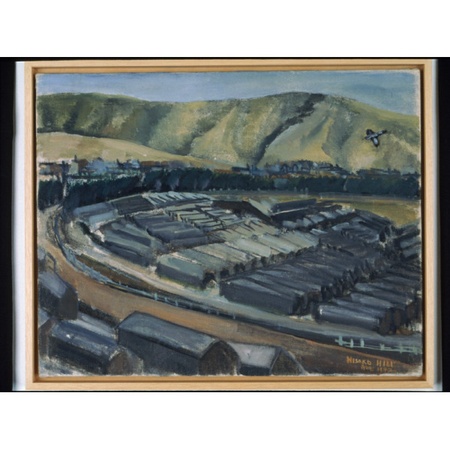
Hisako Hibi - "Tanforan Assembly Center"
Hisako went to the Tanforan Assembly Center before going to Topaz concentration camp. The assembly center used to be a racetrack. And, as you can see, the buildings in the picture are huddled together inside this racetrack. The closeness of the buildings communicates the feeling of being cramped and uncomfortable, things that the prisoners felt often.
--
Description
Unframed, stretched canvas. | Image of crowded rows of dark barracks in and around dirt racetrack at Tanforan Assembly Center in San Bruno, California. A blue bird flies overhead, top right. Green mountain in background.
Inscription
Signed in caps, bottom right: Hisako Hibi / Aug 1942. Written on back: Tanforan Race Track Tanforan Assembly Center San Bruno, Ca we stayed May 8-Sept 23, 1942.
History
This painting is one of only eight known works done by Hisako Hibi at the Tanforan Assembly Center located in San Bruno, California. It is an important visual expression of Hibi's initial impressions of Tanforan and the circumstances of the incarceration. The perspective of the painting offers a panoramic, bird's-eye view of the camp and hence, Hibi's imagined vision of the camp grounds from such a distance. The barracks, which formerly housed race horses, are depicted as rows of buildings closely huddled into the narrow race track enclosure. The shallow space of the painting and the use of a high horizon contribute to the cramped feeling of the work. The bird flying in the top right corner is the only sign of movement and life in the otherwise quiet and somber canvas.
painting
H: 16 in, W: 20 in
canvas
oil
San Bruno, Calif., August 24, 1942
(96.601.1)
Gift of Ibuki Hibi Lee
Hisako Hibi Collection
To see other collections:
Japanese American National Museum Collections Online
Copyright is held by the Japanese American National Museum. Short-term educational use with limited circulation is permitted. For all other uses, please contact the Hirasaki National Resource Center at the Japanese American National Museum (hnrc@janm.org)
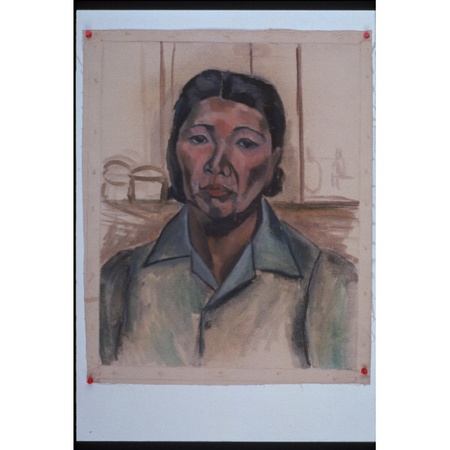
Hisako Hibi - "Study for a self-portrait"
Hisako painted this picture of herself. In it, she has on a collared shirt, and sits among what looks like a kitchen. She doesn't look enthused, probably due to the fact that she is imprisoned in a concentration camp.
--
Description
Self-portrait of Hisako Hibi. Visible from the shoulders up, a woman in a green blouse looks directly at the viewer. Her hair is parted in the middle and appears to be pulled back to the nape of her neck. Rough oil sketch (wash) in background.
painting
H: 21.75 in, W: 17.5 in
canvas
oil
Topaz, Utah, ca. 1944
(99.63.1)
Gift of Ibuki Hibi Lee
Hisako Hibi Collection
To see other collections:
Japanese American National Museum Collections Online
Copyright is held by the Japanese American National Museum. Short-term educational use with limited circulation is permitted. For all other uses, please contact the Hirasaki National Resource Center at the Japanese American National Museum (hnrc@janm.org)
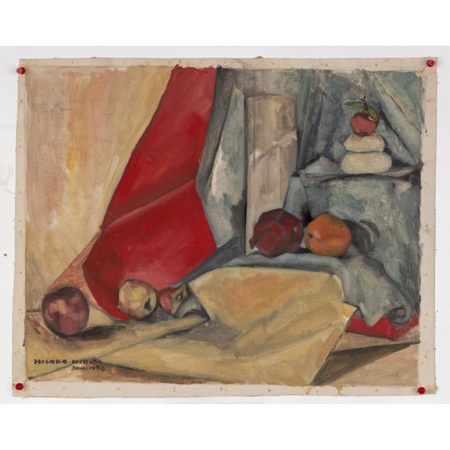
Hisako Hibi - "New Year's Mochi"
Hisako's first New Year at Topaz concentration camp did not include mochi, which is traditionally made and eaten in the Japanese culture during New Year celebrations. So, Hisako painted this picture of mochi, a pomegranate, an orange and apples.
--
Description
Unstretched | Still-life of New Year's kagami mochi topped by tangerine in upper right corner on cloth backdrop. Cylinder-like object stands to the left of the mochi. Below cylindrical object are 2 pieces of fruit, 1 pomegranate on left and 1 orange on the right. Red cloth draped near center with 2 apple as at bottom. Upper left corner is a quick pencil sketch of buildings and people Signed in lower left corner: Hisako Hibi Jan. 1943.
Inscription
On back: Hisako Hibi. Jan 1943 at Topaz. Japanese without mochi (pounded sweet rice) is no New Year! It was very sad oshogatsu (New Year). So, I painted okazari mochi in the internment camp.
painting
H: 17.25 in, W: 21.5 in
canvas
oil
Topaz, Utah, ca. 1944
(99.63.2)
Hisako Hibi Collection
To see other collections:
Japanese American National Museum Collections Online
Copyright is held by the Japanese American National Museum. Short-term educational use with limited circulation is permitted. For all other uses, please contact the Hirasaki National Resource Center at the Japanese American National Museum (hnrc@janm.org)
Hisako Hibi was born in Fukui, Japan in 1907. When she was 13 years old, she came to the United States with her parents. While attending the California School of Fine Arts, now the San Francisco Art Institute, she met fellow artist and future husband, George Hibi. During World War II, Hisako, along with her husband and two children, were incarcerated in Tanforan Assembly Center and then the Topaz concentration camp in Utah. While at camp, Hisako and George stayed involved with art in the camp school system. This collection features some of the paintings that Hisako did while incarcerated. Her art depicts the daily lives and activities of those incarcerated during World War II. To see the rest of Hisako's paintings, please visit the Japanese American National Museum website. Copyright is held by the Japanese American National Museum. Short-term educational use with limited circulation is permitted. For all other uses, please contact the Hirasaki National Resource Center at the Japanese American National Museum hnrc@janm.org
The new Nikkei Album!
We’re excited to share our redesigned Nikkei Album. It’s a work-in-progress, so please have patience as we add more features and functionality. It will be an exciting tool for our community to easily share photos, videos, and text! Learn MoreNew Site Design
See exciting new changes to Discover Nikkei. Find out what’s new and what’s coming soon! Learn More
Discover Nikkei Updates

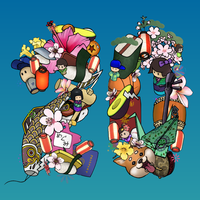

See exciting new changes to Discover Nikkei. Find out what’s new and what’s coming soon!


